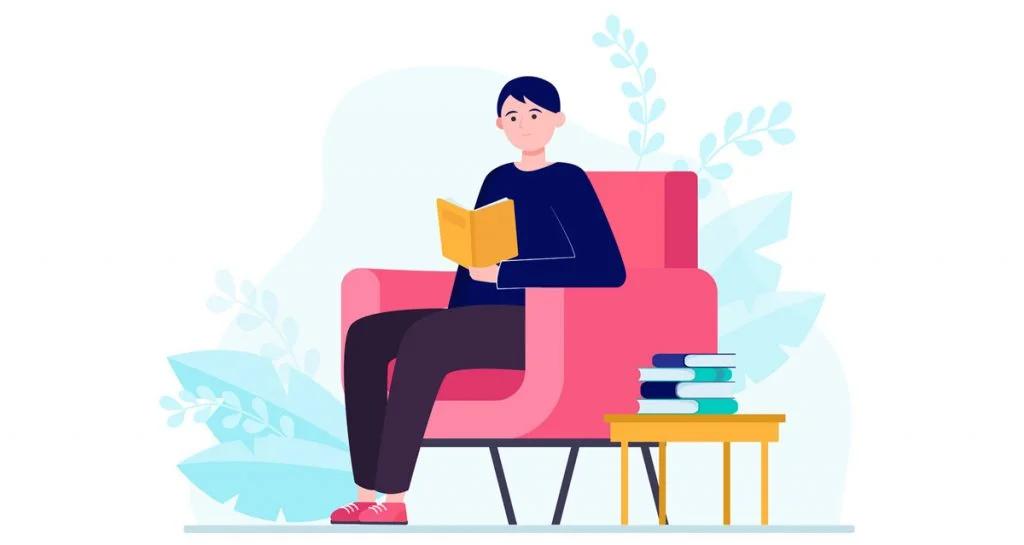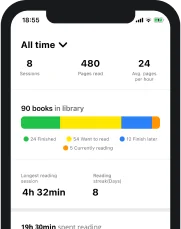While most of us take reading for granted and don’t give it much thought as an activity, others take it a whole lot more seriously and dedicate time and effort to understanding it better. Most of us have the tendency to not even consider the complexity of reading as a mental process and basically do it with a certain level of automatism that does us no good.
The reason I am saying that is the fact that improving ourselves as readers and figuring out ways to become better and more efficient readers should always start with a dedication to understanding it both as a whole and in the tiniest details and components.
What are the five components of reading? Basmo is dedicated to helping each and every one of you become more passionate and more efficient readers, which is why we took a closer look at reading as a process and figured out what its components are and why they all matter.
What are the five components of reading?
The 5 components of reading are defined as the most important five aspects that characterize the reading experience. They are the elements of reading that are basically leading to the complex activity we know and love. Reading is visual, acoustic, introspective, and one of the most powerful learning tools known to man.
Knowing its five components allows us to break it down and understand it to its core, giving us a chance to separately improve on each component separately, which in turn is going to lead to us becoming better, faster, and more efficient readers.
Here are the five essential components of reading:
1. Phonemic Awareness
Phonemic awareness is defined as the ability to successfully identify and use certain sounds or phonemes in words. Phonemes are the smallest unit we can think of when referring to the spoken language.
To better understand what phonemes are, let’s take a look at a simple word like potato, which contains 6 phonemes: p-o-t-a-t-o ( basically the sound each letter represents). To compare, the word photo only contains four phonemes even though it has 5 letters because ph represents a single sound: ph-o-t-o (phonetically ˈfoʊˌtoʊ).
This is the first component and the most important one in reading, on which all the others are practically based. We learn phonemic awareness from a very young age, through songs and poems which highlight the phonemes in rhymes.
As you would expect, phonemic awareness is crucial in learning to read, as nothing can make up for the inability to successfully identify the actual sounds each letter or group of letters should represent.
Children should be able to hear and identify the sounds and patterns in words before they can learn what letters represent those sounds. This is one of the reasons why reading to your children before they learn to read themselves is very important.
They need to be exposed to as much spoken language as possible, to hear as many different words in order to later be able to successfully make the connections between the sounds they know and the letters that have to generate those sounds when read out loud. Being able to recognize the connection between spoken and written language early on is what usually separates good readers from poor ones.
2. Phonics
The second name on the list of reading components is represented by phonics. This component represents the actual connection between the sounds letters are responsible for and the actual symbols that create these letters. In other words, phonemics and letters are strictly connected through phonics.
Learning the basics of phonics is the next step children must go through in order to learn how to read. They need to be able to identify the letters and groups of letters and create the mental connection between them and the sounds they generate. This process includes learning the alphabet and how certain letters generate different sounds when grouped together ( sh, ch – for example).
The importance of this step in the learning to read journey is obvious. It is an essential building block for the upcoming stages and it plays a huge role in the mental development of children.
3. Fluency
Through practice and a good understanding of phonemics and phonics, the next step in the process of learning to read comes down to building fluency. By fluency in reading we understand a smooth reading process, one that has very few or no interruptions. This is actually one of the steps of the process that takes quite long to master.
Children (or adult subjects who are in the process of learning to read) usually tend to find building fluency an overwhelming process. All the phonemic and phonic rules associated with reading need to be followed with a certain level of automatism, which usually comes through a lot of practice.
Being able to read texts fluently, pronouncing all the words correctly, and maintaining a good reading speed is something that can only be achieved through hours of practice, and is closely connected to the next reading component.
4. Vocabulary
As we all know, reading is one of the main ways we can improve our vocabulary, regardless of our age and reading level. Through reading, we get to learn new words constantly and we get familiarized with lots of new expressions or word associations we would normally not naturally think of.
As I mentioned earlier, fluency and vocabulary have a strong connection. On one hand, good fluency gives us a chance to read more and faster, which in turn allows us to learn new words at a higher rate. On the other hand, having a rich vocabulary has a very positive effect on our fluency.
With a rich vocabulary, we have lower odds of finding an unfamiliar word in a text we are reading, which can badly influence our fluency. Familiarizing ourselves with as many words as possible ensures that our fluency is also spot on most of the time.
Reading and repetition go hand in hand when it comes to enriching our vocabulary, which is also closely connected with comprehension, the final essential component of reading. Without repetition, we tend to quickly forget the information we acquire unless we use special mnemonic devices or other memorization strategies. This is why creating healthy reading habits is essential: reading every day ensures that we get a chance to keep our minds constantly engaged and exposed to old and new words.
Can Basmo Help?
This is where Basmo steps in to help you create the healthiest reading habits possible. Here’s how:
Reading schedule
Our reading tracking app allows you to set a clear schedule for your reading sessions. Not only can you select the exact days of the week when you want your reading sessions to take place, but you can also select different times for each day.
The scheduling is highly customizable to provide you with the complete freedom you need.
Setting goals
Our team learned early on that true performance can only be achieved when we have the right mindset. And a good mindset cannot exist without clear goals and expectations. That’s why Basmo, the best reading tracking app out there, has a built-in feature that allows you to set realistic goals for your reading.
You can go for a big-picture goal and focus on the number of books you want to read throughout the year, or you can micromanage your reading habits by having a daily reading goal expressed in a certain number of minutes spent reading every day.
Take notes
Since we’re on the subject of building and enriching our vocabulary, there’s nothing better for our information retention abilities than taking notes. We thought about that as well and that is why an integral part of our app is our note-taking feature.
Whenever a reading session is ongoing, you can simply open the app and start typing whatever you think will be relevant for you later from the book you are reading.
Jot down your thoughts, new words, expressions, or whatever you like. The notes will be saved within the app and more precisely, within the exact book you read them in.
5. Comprehension
The final of the five essential components of reading is, of course, comprehension. Because without it, the whole purpose of reading fades away. Comprehension refers to our ability to absorb information while reading, and that is not limited to memorizing the data we go through.
Comprehension is an absolutely essential aspect of reading because through it we are able to learn new things, understand new concepts, and make sense of the world around us. It is the culmination of the reading skills we acquire and the most relevant goal of this activity.
And, as with the other components I mentioned above, comprehension goes hand in hand with the rest. Fluency and vocabulary both play a huge role in how well and fast we develop our comprehension skills, just as comprehension influences our fluency and ability to learn and remember new words. It’s a lot easier to remember something we understand.
Comprehension is the tip of the spear when it comes to reading and while mastering our comprehension skills can take years (even though we can go a lifetime constantly improving our comprehension abilities), the results will quickly pay off. Comprehension allows us to learn, develop, and take advantage of the full list of benefits that reading can provide.
Why are the 5 components of reading important?
As you probably already noticed if you read the detailed explanation from each reading component above, they all rely on one another. Like with most things in life, one simply cannot cut any corners when it comes to reading, especially if they are hoping to achieve their maximum potential.
Mastering all the five components of reading is crucial if we want to be proficient readers, if we want to use reading as a learning tool, as well as a form of entertainment. Without mastering phonemic awareness, phonics doesn’t make any sense. Without phonics, fluency is impossible. Without fluency, it will be extremely hard for us to enrich our vocabularies. With poor vocabulary, our comprehension levels are going to constantly be quite poor as well.
While phonemic awareness, phonics, and fluency are usually mastered by the time elementary school is over, it’s important to know that the vocabulary and comprehension abilities are limitless and can be improved throughout our entire lives. There’s always a new word to learn, a new concept to familiarize ourselves with or new information to acquire and connect with previously learned concepts. And since reading is one of the most fruitful and healthy activities for our brains, why would we ever stop reading and learning?
With tools like Basmo, reading becomes more fun, more efficient, and a lot more structured and organized. Basmo will allow you to extract maximum value from the time you spend reading, in a very convenient and user-friendly way.
Final thoughts
What are the five components of reading? They are a lot more than just simple steps we need to go through in order to learn how to read and understand what we read. They sit at the core of our education and represent the first building blocks on which our general knowledge, empathy, and ultimately intelligence rely.
Mastering them all is crucial for our general well-being and for being successful in our careers. Use Basmo to take full advantage of your time spent reading and keep on reading and learning.
Give Your Reading Experience
An Extra Boost With Basmo
Track the books you read, monitor the time you spend reading and keep notes on your reading habits and how it makes you feel. You can set yourself targets for the time you spend reading and you can get notified whenever you’re behind on your reading time.
English education vector created by pch.vector – www.freepik.com







